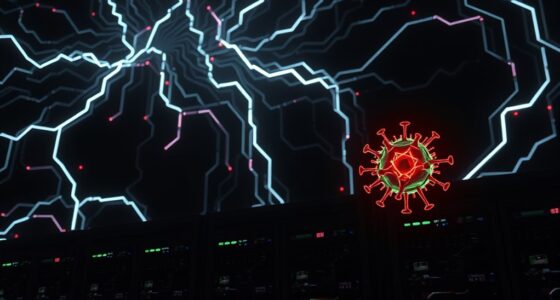As custodians of AI systems, it is imperative that we remain diligent in safeguarding them against the constant danger of cyber attacks. This article outlines six practical strategies that can enhance our defenses.
- Implement strong authentication measures.
- Ensure regular software updates.
- Conduct vulnerability assessments.
- Implement robust encryption protocols.
- Monitor and analyze network traffic.
- Establish incident response and recovery plans.
By implementing these strategies, we can safeguard our AI systems and ensure their uninterrupted operation in the face of potential threats.
Key Takeaways
- Utilize biometric authentication and multi-factor authentication to verify identity and reduce the risk of unauthorized access.
- Timely software updates are crucial to address vulnerabilities, improve system performance, and comply with industry standards.
- Conduct vulnerability assessments, including penetration testing and code review, to identify and mitigate weaknesses in AI systems.
- Implement strong encryption protocols and network traffic monitoring to protect sensitive data and detect potential cyber attacks.
Implementing Strong Authentication Measures
We consistently prioritize implementing strong authentication measures to safeguard AI systems from cyber attacks.
Biometric authentication and multi-factor authentication are two key strategies we employ to ensure the security of our AI systems.

Biometric authentication involves using unique physical or behavioral characteristics, such as fingerprints or facial recognition, to verify the identity of an individual. This adds an extra layer of security as it’s difficult to replicate or forge biometric data.
Additionally, we implement multi-factor authentication, which requires users to provide multiple forms of identification, such as a password and a fingerprint scan. By combining these authentication methods, we significantly reduce the risk of unauthorized access to our AI systems.
Our commitment to implementing strong authentication measures demonstrates our dedication to maintaining the integrity and security of our AI systems.
Ensuring Regular Software Updates
Regular software updates are crucial in safeguarding AI systems from cyber attacks. Timely updates ensure that vulnerabilities present in outdated software are addressed promptly, reducing the risk of exploitation by attackers.

Importance of Timely Updates
Ensuring timely updates for software is crucial in safeguarding AI systems from cyber attacks. Regular software updates play a vital role in maintaining the security and integrity of AI systems. Here are four reasons why timely updates are of utmost importance:
- Patch management practices: Timely updates ensure that any vulnerabilities or weaknesses in the software are addressed promptly. By implementing effective patch management practices, organizations can reduce the risk of potential cyber attacks.
- Security implications of delayed updates: Delaying software updates can leave AI systems vulnerable to cyber threats. Hackers are constantly evolving their techniques, and outdated software can be an easy target. Timely updates help to mitigate security risks and protect AI systems from potential breaches.
- Improved system performance: Software updates often include performance enhancements and bug fixes. By keeping the software up-to-date, organizations can ensure optimal functionality and performance of their AI systems.
- Compliance with industry standards: Many industries have specific regulations and compliance requirements related to software updates. Timely updates help organizations meet these standards and avoid any legal or regulatory consequences.
Vulnerabilities of Outdated Software
To mitigate the vulnerabilities of outdated software, it’s important to maintain regular updates. Updating software ensures that the latest security patches and bug fixes are applied, minimizing the risk of cyber attacks. Patch management plays a crucial role in this process by systematically identifying and applying updates to software systems.
Outdated software poses a significant security risk as it often contains known vulnerabilities that can be exploited by attackers. These vulnerabilities can include software bugs, coding errors, or design flaws. Cybercriminals actively search for and exploit these weaknesses, making regular software updates essential for maintaining the security and integrity of AI systems.
By keeping software up to date, organizations can effectively address potential vulnerabilities and protect against emerging threats. This requires a proactive approach to patch management, including regular monitoring, testing, and deployment of software updates.

Failure to prioritize updating software leaves AI systems exposed to potential cyber attacks and compromises their overall security posture.
Conducting Vulnerability Assessments
To safeguard AI systems from cyber attacks, conducting effective vulnerability assessments is crucial. These assessments help identify any weaknesses or vulnerabilities in the system that could be exploited by attackers.
Effective Vulnerability Assessment
In conducting vulnerability assessments, we employ a comprehensive and proactive approach to identify potential weaknesses in AI systems. Our process involves the following key steps:
- Vulnerability Management: We utilize industry best practices to establish an efficient and systematic process for managing vulnerabilities in AI systems. This includes continuous monitoring, prioritization, and remediation of identified weaknesses.
- Threat Intelligence: We leverage up-to-date threat intelligence to stay informed about emerging risks and vulnerabilities specific to AI systems. This allows us to proactively identify potential attack vectors and mitigate them before they can be exploited.
- Penetration Testing: Through controlled simulated attacks, we assess the resilience of AI systems against potential threats. This helps us uncover vulnerabilities that may not be apparent through traditional assessment methods.
- Code Review and Analysis: We conduct in-depth reviews of AI system code to identify any inherent vulnerabilities or weaknesses that may be present.
By employing these strategies, we can effectively identify and address vulnerabilities in AI systems, ensuring their security and resilience.

Now, let’s explore the next section on mitigating AI system vulnerabilities.
Mitigating AI System Vulnerabilities
By employing comprehensive vulnerability assessments, we actively mitigate AI system vulnerabilities. These assessments involve the systematic identification and analysis of potential weaknesses in AI systems, allowing us to develop effective strategies to protect against cyber attacks.
One key aspect of vulnerability assessments is automated threat detection. This involves the use of machine learning algorithms to detect and respond to potential threats in real-time. By continuously monitoring the behavior and performance of AI systems, we can identify any anomalies or deviations that may indicate a security breach.
Additionally, vulnerability assessments help us identify and address any potential vulnerabilities in the design, implementation, or configuration of AI systems. This allows us to proactively strengthen our defenses and ensure the robustness and resilience of our AI systems against cyber threats.

Implementing Robust Encryption Protocols
Our focus is on creating a secure environment for AI systems through the implementation of robust encryption protocols. Encryption plays a crucial role in safeguarding data and ensuring secure communication between AI systems.
Here are four key strategies to implement robust encryption protocols:
- End-to-end encryption: This method ensures that data is encrypted at the source and can only be decrypted by the intended recipient, protecting it from unauthorized access during transmission.
- Strong encryption algorithms: Implementing advanced encryption algorithms such as AES (Advanced Encryption Standard) or RSA (Rivest-Shamir-Adleman) enhances the security of AI systems, making it more difficult for attackers to decrypt the data.
- Key management: Establishing a secure key management system is essential for securely storing and distributing encryption keys, minimizing the risk of unauthorized access to sensitive information.
- Regular encryption updates: Keeping encryption protocols up to date is crucial to address any vulnerabilities or weaknesses that may be discovered over time, ensuring continuous protection of AI systems.
Monitoring and Analyzing Network Traffic
To effectively secure AI systems, we must actively monitor and analyze network traffic for potential cyber attacks. Network traffic analysis involves examining the data flowing through a network to identify any suspicious or malicious activities. By monitoring network traffic, we can detect anomalies and patterns that may indicate a cyber attack in progress. Anomaly detection techniques, such as statistical analysis and machine learning algorithms, can help us identify abnormal behavior and potential threats. By continuously analyzing network traffic, we can quickly detect and respond to any security breaches, minimizing the potential damage caused by cyber attacks. Below is an emotional response-evoking table showcasing the importance of network traffic analysis and anomaly detection in safeguarding AI systems:
| Network Traffic Analysis | Anomaly Detection |
|---|---|
| Proactive defense | Early threat detection |
| Real-time monitoring | Rapid response and mitigation |
| Identifying attack vectors | Enhanced security |
| Minimizing damage | Protecting sensitive data |
Monitoring and analyzing network traffic is a critical aspect of securing AI systems, as it enables us to stay one step ahead of cyber attackers and protect our valuable assets.

Establishing Incident Response and Recovery Plans
After monitoring and analyzing network traffic, we can then establish incident response and recovery plans for safeguarding AI systems. This crucial step ensures that we’re prepared to handle any potential cyber attacks effectively and minimize the impact on our systems.
To establish incident response protocols and train incident response teams, we need to consider the following:
- Develop a comprehensive incident response plan that outlines the roles, responsibilities, and procedures to follow during a security incident.
- Conduct regular tabletop exercises and simulations to test the effectiveness of the incident response plan and identify areas for improvement.
- Establish clear communication channels and escalation procedures to ensure seamless coordination and information sharing among the incident response team.
- Continuously monitor and update the incident response plan to adapt to evolving threats and vulnerabilities.
Frequently Asked Questions
How Can AI Systems Be Protected From Physical Attacks or Tampering?
To protect AI systems from physical attacks or tampering, we need to implement robust physical security measures and tamper-evident technologies. This ensures the integrity of the AI systems and prevents unauthorized access or manipulation.
What Are Some Common Signs or Indicators of a Cyber Attack on an AI System?
When it comes to safeguarding AI systems from cyber attacks, it is crucial to identify common signs or indicators such as unusual network traffic, unauthorized access attempts, and abnormal system behavior. By recognizing these indicators, we can effectively mitigate potential threats.

Are There Any Legal Considerations or Regulations That Need to Be Taken Into Account When Safeguarding AI Systems From Cyber Attacks?
When safeguarding AI systems from cyber attacks, legal considerations and regulations must be taken into account. These include compliance with data protection laws, intellectual property rights, and industry-specific regulations to ensure secure and ethical use of AI technology.
How Can Organizations Ensure That Their AI Systems Are Protected From Insider Threats or Attacks From Within Their Own Network?
To protect our AI systems from insider threats or attacks within our own network, we implement robust insider threat prevention measures and network security strategies. This ensures the integrity and security of our AI systems.
What Are Some Best Practices for Securely Storing and Managing Sensitive Data Used by AI Systems?
To securely store and manage sensitive data used by AI systems, we implement data encryption to protect against unauthorized access. We also employ access control measures to ensure only authorized individuals can access the data.
Conclusion
In conclusion, safeguarding AI systems from cyber attacks requires implementing strong authentication measures, ensuring regular software updates, conducting vulnerability assessments, implementing robust encryption protocols, monitoring and analyzing network traffic, and establishing incident response and recovery plans.

By following these practical strategies, organizations can enhance the security of their AI systems and protect them from potential threats.
It’s essential to remain proactive and vigilant in order to mitigate the risks associated with cyber attacks on AI systems.











